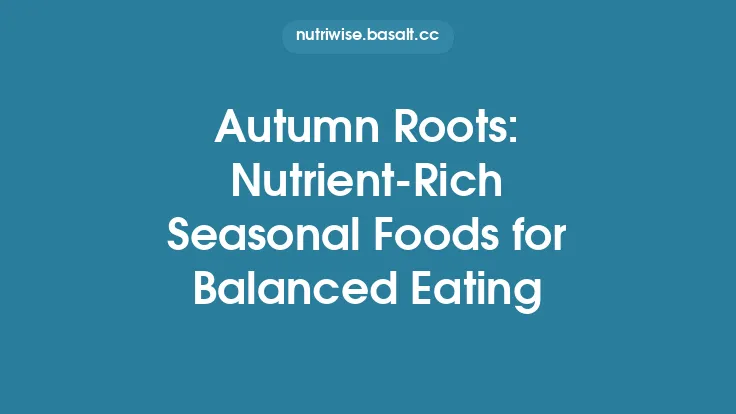The changing calendar brings a natural rhythm to the foods we eat, and science is increasingly revealing why certain seasonal combinations feel especially satisfying—and why they can be especially beneficial for our health. By aligning flavor pairings with the phytochemical peaks of each season, we can craft meals that not only taste harmonious but also maximize nutrient absorption, support metabolic pathways, and promote long‑term wellbeing. Below is a comprehensive guide that translates the latest research into practical, evergreen principles for pairing seasonal ingredients in a way that enhances both flavor and health.
Understanding the Science of Flavor Pairing
Flavor is a multidimensional experience built on three core components: aroma compounds, taste receptors, and mouthfeel. Modern food chemistry shows that many successful pairings share common volatile molecules or complementary metabolic pathways. For example, the aromatic compound eugenol appears in both cloves and cinnamon, creating a natural affinity that our olfactory system perceives as harmonious.
Beyond shared volatiles, recent studies highlight synergistic nutrient interactions. Certain phytochemicals can improve the bioavailability of others—a phenomenon known as the “food matrix effect.” Vitamin C, abundant in many spring greens, enhances iron absorption from plant sources like lentils or spinach. Similarly, the fat‑soluble carotenoids in carrots are better absorbed when paired with a modest amount of healthy fat, such as olive oil or avocado.
Understanding these mechanisms allows us to move beyond trial‑and‑error cooking and deliberately design pairings that amplify health benefits.
Seasonal Phytochemical Profiles and Their Health Implications
Each season brings a distinct phytochemical signature, driven by the plant’s adaptive strategies to temperature, daylight, and pest pressures. Recognizing these signatures helps us select complementary foods that reinforce each other’s strengths.
| Season | Dominant Phytochemicals | Primary Health Benefits |
|---|---|---|
| Winter | Glucosinolates (in cruciferous veg), anthocyanins (deep‑colored root veg), monoterpenes (in winter herbs) | Anti‑inflammatory, detoxification support, immune modulation |
| Spring | Ascorbic acid (vitamin C), flavonoids (in early berries), chlorophyll | Antioxidant protection, collagen synthesis, enhanced iron uptake |
| Summer | Lycopene, beta‑carotene, polyphenols (in stone fruits & tomatoes) | Photoprotection, eye health, cardiovascular support |
| Autumn | Polyphenols (in nuts & seeds), ellagic acid (in berries), omega‑3 fatty acids (in certain seeds) | Neuroprotection, gut microbiome diversity, anti‑oxidative balance |
By aligning pairings with these seasonal profiles, we can create meals that reinforce the body’s natural defenses during each part of the year.
Principles for Pairing Seasonal Ingredients
- Molecular Complementarity – Pair foods that share key aroma compounds or have complementary taste receptors (e.g., sweet‑umami, bitter‑sour).
- Nutrient Synergy – Combine a nutrient that enhances the absorption of another (e.g., vitamin C with non‑heme iron; healthy fats with fat‑soluble vitamins).
- Texture Contrast – Pair a crisp, high‑water‑content ingredient with a creamy or fibrous component to stimulate oral mechanoreceptors and improve satiety.
- Thermal Balance – Match warming spices with cold‑season produce to support thermogenesis, or pair cooling herbs with hot‑season foods to maintain homeostasis.
- Seasonal Timing – Use ingredients at their peak phytochemical concentration, which typically occurs a few weeks after harvest, to maximize health impact.
Applying these principles yields pairings that are both scientifically sound and sensorially pleasing.
Winter Pairings: Root Vegetables and Warm Spices
Core Concept: Winter crops such as carrots, parsnips, and turnips accumulate glucosinolates and anthocyanins, which have potent anti‑inflammatory properties. Warm spices like ginger, turmeric, and cinnamon contain bioactive terpenes that further modulate inflammation and support metabolic health.
Science‑Backed Pairings
- Carrot + Turmeric + Olive Oil – Turmeric’s curcumin is fat‑soluble; a drizzle of olive oil improves its bioavailability while the beta‑carotene in carrots benefits from the same lipid medium.
- Parsnip + Ginger + Coconut Milk – Ginger’s gingerol synergizes with the glucosinolate breakdown products of parsnips, enhancing detox pathways in the liver. Coconut milk provides medium‑chain triglycerides that aid in the absorption of both compounds.
- Beetroot + Cinnamon + Walnut Oil – Beetroot’s betalains are antioxidant; cinnamon’s cinnamaldehyde supports glucose regulation. Walnut oil supplies omega‑3s, which complement the anti‑oxidative action of both ingredients.
Health Outcome: Regular inclusion of these pairings can help maintain immune resilience during colder months and support healthy blood sugar regulation.
Spring Pairings: Fresh Herbs and Young Greens
Core Concept: Early‑season greens (e.g., arugula, watercress, baby kale) are rich in vitamin C, folate, and chlorophyll, while spring herbs such as mint, basil, and dill provide volatile phenolics that aid digestion and possess antimicrobial properties.
Science‑Backed Pairings
- Watercress + Lemon Juice + Avocado – Vitamin C from lemon boosts iron absorption from watercress; avocado’s monounsaturated fats enhance the uptake of fat‑soluble phytonutrients.
- Baby Kale + Dill + Fermented Soy – Dill’s dillapiole supports gut motility, while fermented soy supplies probiotic bacteria that thrive on the fiber in kale, fostering a healthy microbiome.
- Arugula + Mint + Quinoa – The peppery glucosinolate profile of arugula pairs with mint’s menthol, which stimulates oral thermoreceptors, enhancing satiety. Quinoa provides complete protein, completing a balanced amino acid profile.
Health Outcome: These combinations promote optimal nutrient absorption, support detoxification, and lay a foundation for a robust gut microbiome during the season of renewal.
Summer Pairings: Bright Fruits and Light Proteins
Core Concept: Summer’s bounty of lycopene‑rich tomatoes, beta‑carotene‑laden peaches, and polyphenol‑dense berries aligns well with lean proteins that are low in saturated fat, allowing the fruit’s antioxidants to act without competition from excess lipids.
Science‑Backed Pairings
- Tomato + Basil + Chickpeas – Lycopene’s absorption is enhanced by the presence of healthy fats; a modest drizzle of extra‑virgin olive oil (or the natural oil in chickpeas) accomplishes this while basil’s eugenol adds a complementary aromatic note.
- Peach + Greek Yogurt + Flaxseed – Vitamin C in peach aids the conversion of plant‑based iron from flaxseed, while the probiotic cultures in yogurt improve gut health, facilitating the metabolism of polyphenols.
- Blueberries + Grilled Tofu + Lime Zest – The anthocyanins in blueberries are stabilized by the acidic environment created by lime, and tofu’s isoflavones work synergistically with blueberry polyphenols to support cardiovascular health.
Health Outcome: Pairings that combine summer fruits with light proteins and a touch of healthy fat maximize antioxidant activity and support cardiovascular function.
Autumn Pairings: Nuts, Seeds, and Earthy Roots
Core Concept: As days shorten, plants store energy in the form of complex carbohydrates, polyphenols, and essential fatty acids. Autumn produce such as pumpkins, sweet potatoes, and squash is high in beta‑carotene and fiber, while nuts and seeds deliver omega‑3 fatty acids, vitamin E, and phytosterols.
Science‑Backed Pairings
- Pumpkin + Pumpkin Seeds + Sage – The zinc in pumpkin seeds supports the activity of antioxidant enzymes that protect beta‑carotene from oxidative degradation; sage’s rosmarinic acid adds an anti‑inflammatory layer.
- Sweet Potato + Walnuts + Rosemary – Walnuts supply alpha‑linolenic acid, which improves the bioavailability of sweet potato’s carotenoids. Rosemary’s carnosic acid works synergistically with these carotenoids to protect retinal health.
- Butternut Squash + Chia Seeds + Thyme – Chia’s soluble fiber slows glucose absorption, complementing the low glycemic index of butternut squash; thyme’s thymol further supports immune function.
Health Outcome: These pairings help sustain energy levels, protect against oxidative stress, and support brain health as the body transitions into cooler months.
Practical Tips for Implementing Pairings in Meal Planning
- Create a Seasonal Pairing Matrix – List the dominant phytochemicals for each season and map compatible foods based on the principles above. This visual tool simplifies weekly menu design.
- Batch‑Prep Complementary Bases – Prepare a neutral base (e.g., roasted root veg, quinoa, or lentil puree) that can be quickly combined with season‑specific flavor partners.
- Mind the Cooking Method – Light sautéing or steaming preserves volatile compounds; excessive heat can degrade heat‑sensitive phytochemicals like vitamin C. Pair heat‑stable ingredients (e.g., glucosinolates) with those that benefit from gentle cooking.
- Portion Fat Strategically – Add a measured amount of healthy fat (1–2 teaspoons) at the end of cooking to maximize absorption of fat‑soluble nutrients without overloading calories.
- Track Personal Responses – Keep a simple log of energy levels, digestion, and mood after meals. Over time, patterns will emerge that help fine‑tune pairings to individual metabolic needs.
Integrating Pairings into Balanced Meals
While the focus here is on flavor synergy, it is essential to embed these pairings within a balanced macronutrient framework:
- Protein: Aim for 20–30 % of total calories from high‑quality sources (legumes, fish, poultry, tofu). Pair proteins with the seasonal flavor combos to ensure complete amino acid profiles.
- Carbohydrates: Choose complex, fiber‑rich carbs that align with the season (e.g., whole‑grain barley in winter, fresh peas in spring). Their slower digestion complements the nutrient release from paired phytochemicals.
- Fats: Prioritize monounsaturated and polyunsaturated fats (olive oil, nuts, seeds) that act as carriers for fat‑soluble vitamins and phytochemicals.
- Micronutrients: Use the seasonal pairing matrix to guarantee a broad spectrum of vitamins and minerals, reducing the need for supplementation.
By weaving scientifically validated pairings into this macro‑balanced scaffold, meals become both nutritionally complete and sensorially satisfying.
Future Directions and Personalization
Emerging research in nutrigenomics suggests that individual genetic variations influence how we metabolize specific phytochemicals. For instance, polymorphisms in the GST (glutathione S‑transferase) gene affect glucosinolate metabolism, meaning some people may derive greater anti‑cancer benefits from cruciferous pairings than others.
Personalization Strategies
- Genetic Testing: If accessible, use nutrigenomic panels to identify sensitivities or enhanced pathways (e.g., CYP1A2 for caffeine metabolism, which can inform spice choices).
- Microbiome Profiling: Certain gut bacteria specialize in converting polyphenols into bioactive metabolites; a diverse microbiome can amplify the benefits of berry‑seed pairings.
- Continuous Monitoring: Wearable devices that track glucose, heart rate variability, and sleep can provide feedback on how specific seasonal pairings affect physiological markers.
As the science evolves, the evergreen principles outlined here will remain a solid foundation, while personalization layers will allow each individual to fine‑tune their seasonal flavor strategy for optimal health.
By grounding seasonal flavor pairings in robust biochemical research, we can move beyond intuition to a disciplined, health‑centric approach to meal planning. The result is a culinary experience that honors the natural rhythm of the year, delights the palate, and supports the body’s intricate metabolic orchestra—today, tomorrow, and for years to come.





